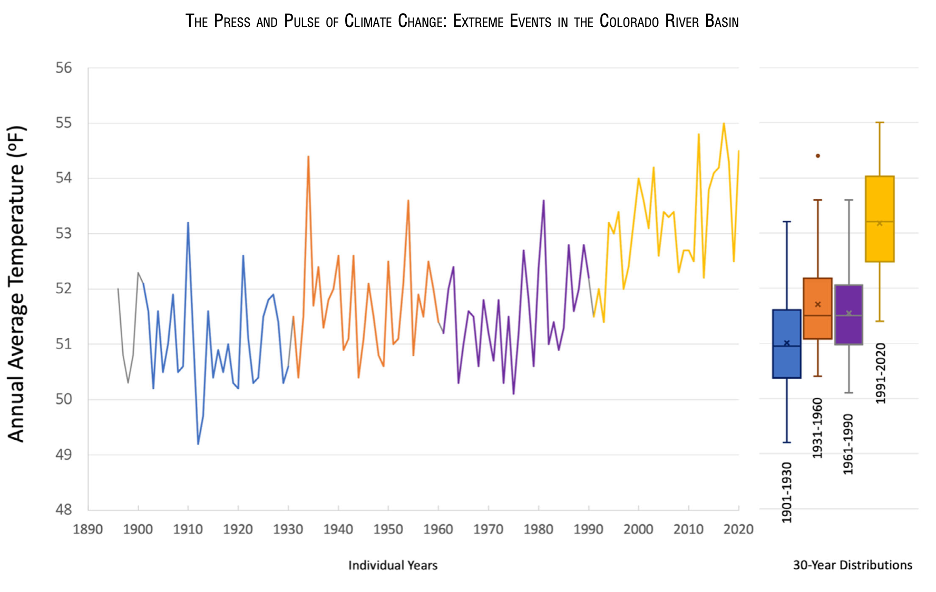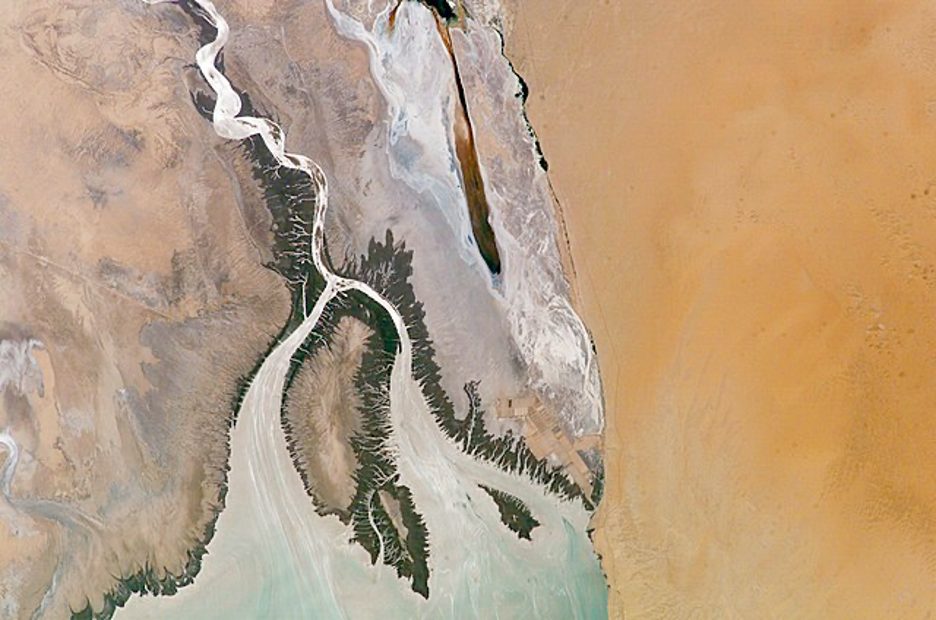Energy Innovation Policy & Technology LLC® partners with the independent nonprofit Aspen Global Change Institute (AGCI) to provide climate and energy research updates. The research synopsis below comes from AGCI’s Climate Science Fellows Tanya Petach and Emilio Mateo. A full list of AGCI’s updates covering recent climate change and clean energy pathways research is available online at https://www.agci.org/solutions/quarterly-research-reviews.
This year, as the Colorado River Basin enters its 23rd consecutive year of drought, water users across the Southwest are grappling with the consequences. As water managers, elected officials, municipal planners, farmers, and tribes all prepare for the high-stakes renegotiation of the Colorado River Compact, scientists are critically examining historical research on the river’s flow to ensure water users across the western United States and Mexico have the information they need to prepare for a future where drought is the norm.
Using Historic Records to Make Sense of the Colorado River’s Future
Connecting the Rocky Mountains to the Gulf of California, the Colorado River shepherds snowmelt from the high peaks in Colorado, Wyoming, and Utah some 1,400 miles across the arid deserts of New Mexico, Nevada, Arizona, California, and Mexico. Because more than 70 percent of the water in the Colorado River originates as snow, year-to-year flow varies in tandem with the Rocky Mountain snowpack. As a result, the Colorado River has oscillated between extremes; withering droughts and catastrophic floods are both peppered throughout the river’s paleorecord.
Using clues from environmental indicators like pollen records and tree-ring widths, paleoclimate conditions in the Colorado River Basin have been mapped as far back as 1 CE (Common Era). The data tell a clear story: extreme, persistent, and severe droughts have long characterized the Colorado River. After one notably severe drought struck the Colorado River Basin near the end of the 13th century, the Ancestral Puebloans, a group who had inhabited the Colorado Plateau for the prior millennium, migrated out of the area into the Rio Grande region.
Paleoclimate reconstructions of historic river flows aren’t a particularly new research technique. Ever since scientists developed the first tree-based paleorecord of Colorado River droughts in 1965, the looming threat of a severe Colorado River drought has concerned the water sector. In 1995, a team of scientists coordinated through the Powell Consortium studied the consequences of a hypothetical severe, sustained drought in the Colorado River Basin. Their research, published in the Journal of American Water Resources (JAWRA) and frequently referred to as the “SSD study,” has been a catalyst for water managers, policymakers, and water users in the decades since its publication.
The SSD study was, remarkably, published in a non-drought era. The two largest reservoirs on the river, Lake Powell and Lake Mead, were both filled to the brim, and annual snowpack hovered comfortably around average at the time of publication. Equally notable is the fact that the study focused not only on the hydrologic impacts of a hypothetical drought, but also on the social, economic, and environmental impacts that drought would have on the Southwest. The authors addressed creative, preventive institutional alternatives for coping with drought, even dipping a toe into near-taboo controversies in the Colorado River Basin, such as interstate water marketing.
The SSD study hinged upon paleoclimate records in the Colorado River Basin. It began with a tree-ring analysis to identify the most severe drought period on record in the Basin (in this analysis, a late 16th-century drought), which was then used as a template for a hypothetical drought scenario. The hypothetical drought’s intensity was increased by reordering the years of the 16th-century drought such that streamflow decreased sequentially for the first 16 years, followed by a period of higher flow until the river returned to conditions within the “normal” range.
The modeled fallout of this hypothetical drought was split between the Upper Basin (Colorado, Utah, Wyoming, New Mexico, and part of Arizona) and the Lower Basin (the rest of Arizona, Nevada, and California). The SSD predicted that Upper Basin states would experience heavy water cuts while Lower Basin states would see fewer impacts. Hydropower outputs from dams steadily decreased during the early years of the drought, with a marked drop in hydropower output in the middle of the drought after Lake Powell fell below minimum powerpool (the elevation at which water can no longer exit reservoirs through turbines and generate hydropower).
In the SSD scenario, Lake Powell reached an elevation too low for water to exit the reservoir from any outlet pipes—a phenomenon often referred to as deadpool—near the end of the theoretical drought, after which the modeled drought eventually ended, reservoirs re-equilibrated, and the Colorado River returned to normal operating conditions. The SSD asserts that “the simulations show that the Colorado River system would be remarkably resilient in the face of an exceptionally extreme, even unrealistic drought of the sort postulated in this study.”
Despite eventual recovery in the Colorado River Basin, years of deadpool conditions in major reservoirs and extreme water cuts to municipalities and agricultural uses wreaked havoc across the Southwest in the modeled SSD scenario. The authors published a suite of preventive recommendations for water managers in the Basin, suggesting alternative governance structures that could (1) reallocate water from low- to high-value uses during times of shortage, (2) manage reservoirs to minimize evaporative losses, and (3) maintain powerpool in reservoirs.
Just five years after the SSD was published, the Colorado River entered what would become known as the “millennium drought,” a 23-year (and counting) period of low flows, dwindling reservoir supplies, and changing hydrology across the Southwest. The current drought is not as severe as the one hypothesized in the SSD, but flows have averaged just 75 percent of total allocated water rights, and Lake Powell is barely above minimum powerpool elevations. Some of the predictions in the SSD have struck close to home (e.g., intense water use cuts, depleted reservoirs, hard trade-offs between environmental and economic water uses); others have not (yet) occurred.
Future Impacts in a Changing Climate
In 2022, the Colorado River science community reviewed the SSD and contextualized it within the millennium drought by publishing a suite of studies in a special issue for the same JAWRA journal (Frisvold et al., 2022). These studies reevaluate the SSD with more powerful computers, a deeper understanding of climate change, and two decades of hands-on drought experience.
The 2022 special issue is steeped in the context of climate change. Updated models presented in the special issue incorporate global climate models and tend to predict streamflow outcomes more accurately than previous models. Current streamflow projections published in the special issue indicate that flow will likely continue to decline in the face of climate change and increasing temperatures and that reservoir levels are unlikely to recover as quickly or to the full extent projected at the end of the SSD.

Average annual temperature for the southwest climate region, through which the Colorado River flows. Trends indicate that annual temperatures are increasing both in terms of extreme events (seven of the eight years on record in which annual temperature exceeded 54 degrees F have occurred since 2003) and average trends (see the 30-year distributions to the right). Figure from McCoy et al., 2022 (one of the many studies that make up the 2022 special issue)
Whereas the 1995 study characterized the drought scenario as “exceptionally extreme, even unrealistic,” many of the studies that make up the 2022 special issue do not investigate the possibility of a drought-free future scenario at all but assume that the millennium drought will continue in the near future. Despite these differences, the 2022 special issue mirrors the SSD as a dazzling example of scientists bridging the research-practice boundary. Across the board, the special issue presents scientific findings in parallel with calls for creativity and resilience in the face of a bleak outlook for the Colorado River Basin.
Projected streamflow declines presented in the special issue are paired with a suggestion to create systems to reallocate water across uses, not just between users in the same sector. A study on the shaky future of recreation on Lake Mead and Lake Powell highlights the need for lakeside communities to diversify economic interests beyond reservoir tourism. The threat of Lake Powell and Lake Mead dropping below deadpool poses significant challenges to the environment in and around the Colorado River, particularly fish and riparian habitats. Temperature swings and the possibility of entirely dry stretches of river lead ecologists to stress the importance of significantly reducing water use across the entire Colorado River Basin in order to increase reservoir storage.
Moreover, the 2022 special issue expands its investigation beyond the impacted water users highlighted in the SSD to include both tribes and Mexico. A dive into the economic impacts of decreased irrigation water on reservations, including the Navajo, Tohono O’odham, and Uintah and Ouray Nations, projects reduced hay yields and even greater decreases in cattle yields. Another study in the special issue investigates the successes and challenges of trans-boundary restoration efforts in the Colorado River Delta. While habitat restoration has been successful and a common goal for both the United States and Mexico, restored areas are small and rely on continued support and water delivery from a shrinking water supply.

The 2022 special issue provides an update on the SSD and an expansion of represented interests. Both publications paint a bleak picture of a drought-stricken U.S. Southwest, and given the reality of increased impacts from climate change, a respite feels unlikely. However, the Colorado River’s headwater snowpack is currently well above average in January 2023 (though that could change over the remainder of the winter) despite tentative projections this fall for a bleak snowpack. In the context of a multi-decade drought, one (potentially) good year’s snowpack won’t lift the basin out of water scarcity. But it may provide a short window for the Colorado River Basin to catch its breath and for the scientific community to join forces with water managers and users across the Southwest to implement creative, innovative solutions in the 11th hour of this wicked problem.
Works Cited:
Linda S. Cordell et al., “Mesa Verde Settlement History and Relocation: Climate Change, Social Networks, and Ancestral Pueblo Migration,” Kiva 72, no. 4 (2007): 379-405.
Ryan S. Crow et al., “Redefining the Age of the Lower Colorado River, Southwestern United States,” Geology 49, no. 9 (2021): 635-640.
H.C. Fritts, “Tree-Ring Evidence for Climatic Changes in Western North America,” Monthly Weather Review 93 (1965): 421-443.
Subhrendu Gangopadhyay et al., “Tree Rings Reveal Unmatched 2nd Century Drought in the Colorado River Basin,” Geophysical Research Letters 49, no. 11 (2022): e2022GL098781.
Eric Kuhn and John Fleck, Science Be Dammed: How Ignoring Inconvenient Science Drained the Colorado River (Tucson: University of Arizona Press, 2019).
Andrea J. Ray et al., “Climate Change in Colorado: A Synthesis to Support Water Resources Management and Adaptation,” Colorado Water Conservation Board Rep 52 (2008).
Connie A. Woodhouse, Stephen T. Gray, and David M. Meko, “Updated Streamflow Reconstructions for the Upper Colorado River Basin,” Water Resources Research 42, no. 5 (2006).
Mu Xiao and Dennis P. Lettenmaier, “Atmospheric Rivers and Snow Accumulation in the Upper Colorado River Basin,” Geophysical Research Letters 48, no. 16 (2021): e2021GL094265.
Featured Collections Cited:
George B. Frisvold et al., “Featured Collection: Severe Sustained Drought: Managing the Colorado River System in Times of Water Shortage 25 Years Later—Part I,” JAWRA Journal of the American Water Resources Association 58, no. 5 (2022): 597-784.
Robert A. Young et al., “Featured Collection: Severe Sustained Drought: Managing the Colorado River System in Times of Water Shortage,” JAWRA Journal of the American Water Resources Association 31, no. 5 (1995): 780-944.